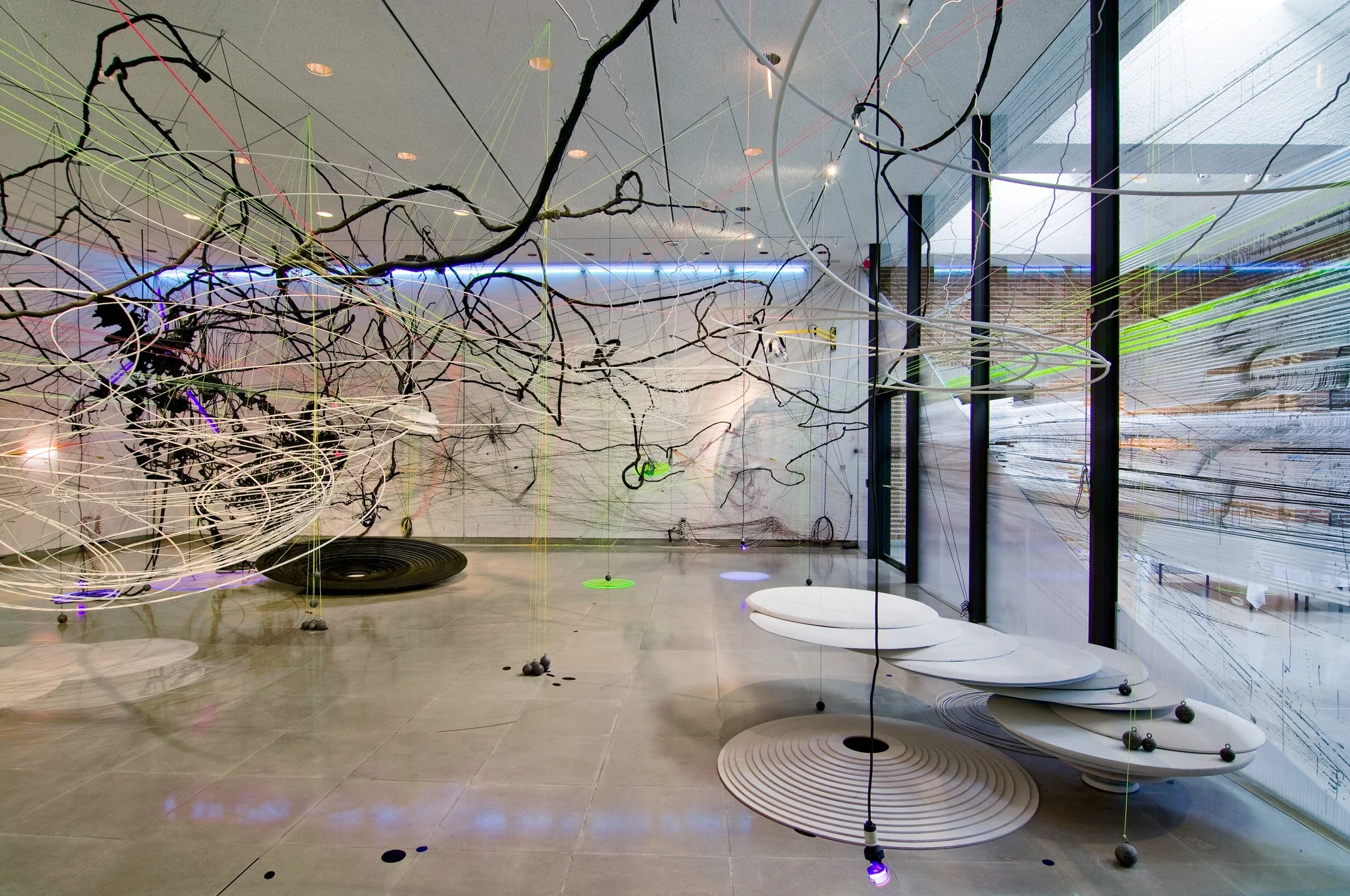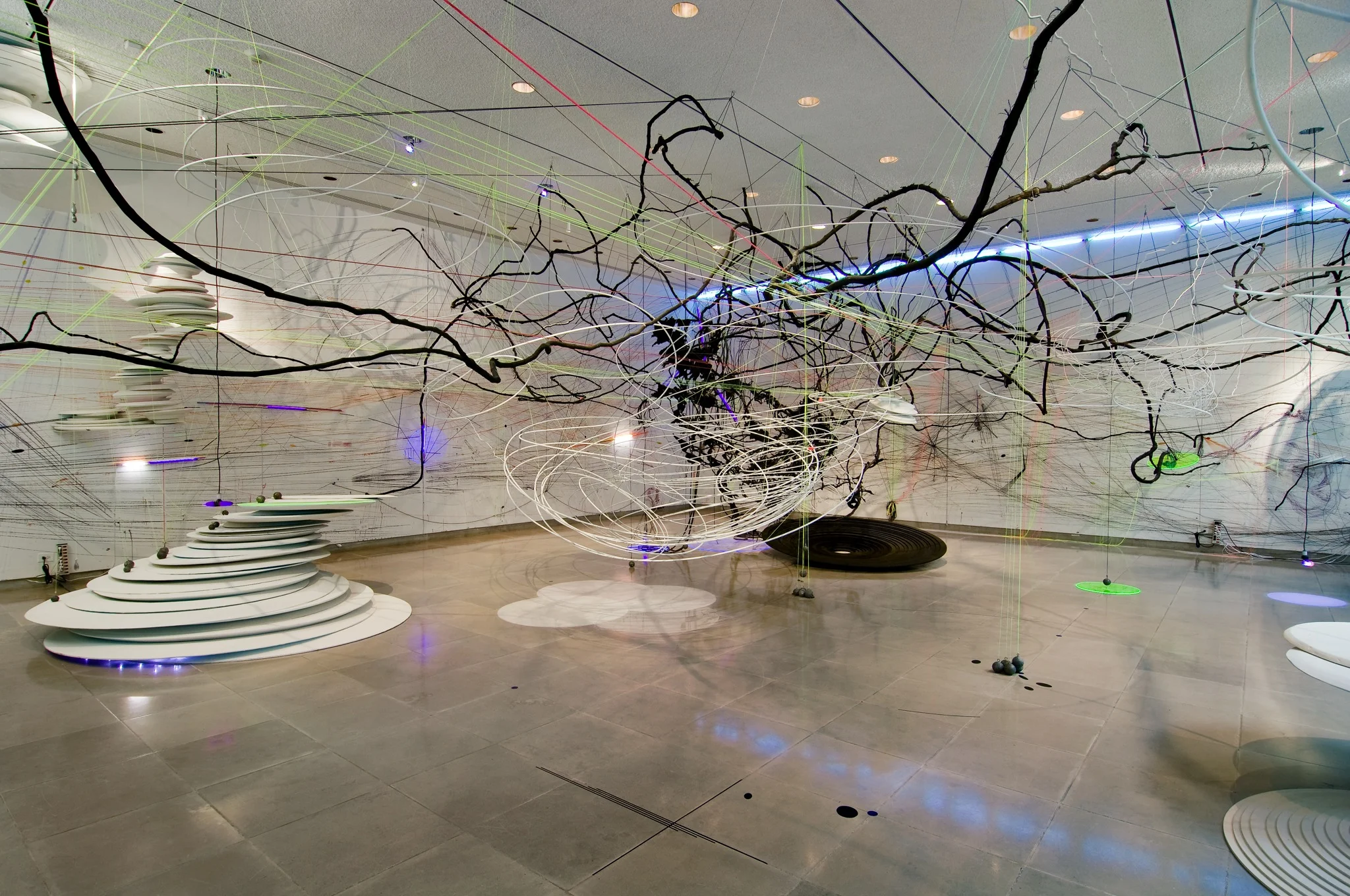Judy Pfaff .....all of the above
1 FEBRUARY - 1 APRIL 2007
Judy Pfaff is a pioneer of installation art and one of its most influential practitioners. Since the start of her prolific career as a sculptor, painter, printmaker, and installation artist, Pfaff has been recognized for her innovative approach to space. In the 1970s, when the dominant trend in art was “cool” in feeling and minimalist in form, Pfaff began making colorful, visually active environments that encompassed an entire gallery. Not limiting herself to a single medium, she incorporated a range of everyday and industrial materials such as wire, plastic tubing, and fabric into carefully structured installations that appeared to be spontaneous. In 2004, Pfaff was named a MacArthur Fellow and joined the illustrious roster of recipients of what is colloquially known as the “genius grant.”
The installation’s title, … . . all of the above, is an idiom Pfaff uses often. Connoting a wide sweep of possibilities, it is an apt choice for an artist whose work thrives on the complexity of life and fluidity of the creative process. “We live in an unsettled, unstable world,” says Pfaff. “It is raucous and staccato … and an installation, with its total openness, allows me to plunge into that spacey void and edit the chaos into a dramatic and sensual environment.” Work on … . . all of the above began in Pfaff’s 2,100 square foot studio in upstate New York, not far from where she teaches at Bard College. In mid-January, Pfaff and four assistants arrived in Houston, bringing with them a truck full of tools, welders, pre-cut installation components, as well as raw material, and began to experiment. Pfaff enters an exhibition space not knowing exactly what will happen. She must rely on her knowledge, skill, and experience to carry her through. “What form it takes, what happens during making it, that’s probably 30 or 40%, but usually I have a pretty strong idea about what it is going to be about,” says Pfaff. Her process is gutsy and fluid - there is no “safe” fallback plan. Her work has been described as “danc(ing) at the edge of chaos.” Pfaff’s art is quintessentially site-specific; her installations grow organically within their spaces as she accumulates, subtracts, and refines their elements.
Walking into … . . all of the above is like entering a three-dimensional drawing; the gallery is filled with overlapping linear elements with a variety of materials suspended and layered in space. There is no focal point, but rather an environment to be explored and experienced. Vines, gathered from the artist’s upstate New York property and stained with dye, snake across the ceiling like lines brushed in Sumi ink. Tattered pieces of matte black foil, the sort used on photographer’s lights, cling to the vines like rotting matter. Huge white spirals of welded steel rings entwine themselves with the vines while drippy parallel lines run across the walls like an exercise in perspective drawing. To create these elegant arcing marks, Pfaff dipped rope in dye and then snapped it against the wall, a dramatic drawing gesture writ large.
Yellow and orange Day-Glo string crisscrosses the room and angles to the floor. Activated by UV light, the luminous geometry of the string contrasts with the dark meandering nature of the vines. Metal spheres cast from cannonballs hang from the ceiling like plumb bobs. On the floor different-sized circles of foam board coated with joint compound are stacked into Dr. Seuss-like towers.
Pfaff’s working process is intuitive and highly physical. She addressed every aspect of Rice Gallery’s 40 foot by 44 foot space, so undaunted by scale and technical challenges that you would think she was making a diorama in a shoe box. Pfaff is used to working large; her permanent installation at the Philadelphia Convention Center, cirque, CIRQUE, is reputed to be the largest suspended sculpture in the world. Pfaff’s massive studio in upstate New York is filled with winches, welding equipment, a forklift, and pressure washers. She uses the accoutrements of a machine shop to create work that has been called “exuberant,” “lush,” “tumultuous,” and “gorgeous.” Pfaff’s art is never just about scale, and her installation isn’t simply about abstract form. Her deft but sensitive use of materials creates a wordless narrative that runs through the space.
ABOUT THE ARTIST
Judy Pfaff was born in London in 1946 and raised in Detroit. She received a BFA from Washington University in St. Louis, Missouri in 1971 and an MFA from Yale University in 1973. In September 2004, the John D. and Katherine T. MacArthur Foundation named Pfaff a MacArthur Fellow. In the midst of a prolific career as a sculptor, installation artist, painter, and printmaker, Pfaff has mounted over 100 solo exhibitions and installations in galleries and museums worldwide, including The Museum of Modern Art, New York and the Whitney Museum of American Art, New York. Judy Pfaff is the Richard B. Fisher Professor in the Arts, Bard College, Annandale-on-Hudson, New York.
Photos by Nash Baker © nashbaker.com









